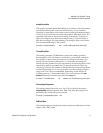
StorNext File System Tuning
File Size Mix and Application I/O Characteristics
StorNext File System Tuning Guide 6
It is usually best to configure the RAID stripe size no greater than 256K
for optimal small file buffer cache performance.
For more buffer cache configuration settings, see Mount Command
Options on page 17.
NFS / CIFS 0
It is best to isolate NFS and/or CIFS traffic off of the metadata network to
eliminate contention that will impact performance. For optimal
performance it is necessary to use 1000BaseT instead of 100BaseT. On
NFS clients, use the vers=3, rsize=262144 and wsize=262144 mount
options, and use TCP mounts instead of UDP. When possible, it is also
best to utilize TCP Offload capabilities as well as jumbo frames.
It is best practice to have clients directly attached to the same network
switch as the NFS or CIFS server. Any routing required for NFS or CIFS
traffic incurs additional latency that impacts performance.
It is critical to make sure the
speed/duplex settings are correct, because
this severely impacts performance. Most of the time
auto-detect is the
correct setting. Some managed switches allow setting
speed/duplex (for
example
1000Mb/full,) which disables auto-detect and requires the host to
be set exactly the same. However, if the settings do not match between
switch and host, it severely impacts performance. For example, if the
switch is set to
auto-detect but the host is set to 1000Mb/full, you will
observe a high error rate along with extremely poor performance. On
Linux, the
mii-diag tool can be very useful to investigate and adjust speed/
duplex
settings.
If performance requirements cannot be achieved with NFS or CIFS,
consider using a StorNext Distributed LAN client or fibre-channel
attached client.
It can be useful to use a tool such as
netperf to help verify network
performance characteristics.


















